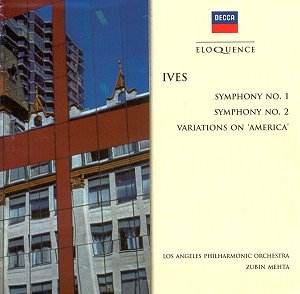Anyone contemplating buying this disc needs to know
of Decca’s complete set of the four Ives Symphonies in its bargain "double
disc" series. It includes the same Mehta performance of the First
Symphony (but not his No. 2) and is readily available. More of
that later.
The first two symphonies are early works completed
in 1898 and 1902 respectively, neither receiving their premieres for
half a century. Fortunately Ives lived to hear them– but only just.
Not that he needed to: he always claimed he could hear exactly what
he had written in his mind’s ear.
It is only in the Second Symphony that the voice of
the Ives we know begins to emerge. The First is a student work written
when he was at Yale, spending three years on it off and on. It was submitted
as his main thesis and as such would have needed to please the Professor,
Horatio William Parker, himself a composer. Parker had tried to knock
out of his student a tendency to eccentricity and innovation, something
Ives had inherited from his musician father. The symphony is a superb
example of toeing the line.
When listening to the early major efforts of composers
it is hard to resist playing the game of ‘spot the influences’. In this
case the names Tchaikovsky and sometimes Wagner come up (Ives claimed
not to be fond of either), but what struck
me most forcibly this time around is a really pervading Dvořák
influence. This is apt, or maybe ironic, because Dvořák had arrived
in New York in 1892 to take over the Conservatory and one of the briefs
given to him by rich benefactor Mrs Jeannette Thurber
was to found a national school of composition. The Dvořák influence
is clearly apparent in much of the skilful orchestration but more endemic
is the fundamentally melodic approach to symphonic writing rather than
one that is Beethovenianly motivic. To
pull this off you need, like Dvořák, a gift for tune writing and
the confidence to flaunt it. Ives has and does. For example, the work
plunges straight into a winner of a tune (in a similar way to the glorious
opening of’ Dvořák’s Third). In the second movement
Adagio beautiful melody is the key,
even if it does, with the cor anglais opening, embarrassingly derive
from the famous adagio from Dvořák’s New World which
had been premiered in New York five years earlier. Now it is this sort
of thing that has led to descriptions of the symphony such as "pleasant
but disconnected set of romantic clichés". Personally, I
had far rather listen to this ingenuous work than many symphonies by
more mature composers that are generally considered more worthy.
Mehta’s performance really does help the work to convince.
He takes it upon himself to cut out most repeats and I suspect this
may be a good thing in curbing youthful symphonic incontinence. But
there is a conviction in the performance that always keeps things moving
and the playing of the Los Angeles Philharmonic strings will, I am sure,
disarm "romantic cliché" cynics. It is in this department
that, for example, the Nashville Symphony Orchestra cannot compete in
their Naxos disc of the Second Symphony.
The Second is a very different work in spite
of its romanticisms, being recognisably Ives with its incorporation
of well-known American tunes. In the second of the five movements, which
really sounds like a first movement allegro following a slow introduction
that is the actual first, he weaves in a civil war song, a hymn and
a college song. In the last movement the technique is taken further
still. Mehta’s performance is as good as any on disc and more convincing,
for example, than Dohnányi’s with the Cleveland Orchestra. Which
brings me back to the issue of Decca’s set of the four symphonies.
In the set, Dohnányi takes the Second and
Fourth Symphonies with Marriner and the Academy of St Martin
in the Fields taking the Third. Mehta’s First is probably
the best performance and Marriner’s the least successful. Those wishing
to come to grips with Ives’ symphonic output should seriously consider
it as an excellent buy (two substantial Ives fillers are included).
Alternatively, what the Mehta disc under discussion here provides is
very good performances of the first two symphonies on one disc with
the popular William Schumann orchestration of Variations on ‘America’
as a filler. Over to you.
John Leeman
Comment from a reader
Thank you for the excellent work that you do on your site. I'm a regular
reader.
I thought I might also point out that the above review
contains a few errors.
John Leeman, claims that Ives heard the premieres of both his First
and Second symphonies. This isn't true. He only heard the premiere of
the Second. (Actually, Ives only heard it on the radio, as he declined
to attend the actual performance.) With regards to the First, Ives died
in 1954 and the this symphony was premiered in 1966. So he never heard
a complete performance of this work, only individual movements.
Also, the author of the review mistakenly claims that von Dohnanyi
recorded the Second symphony in the "Decca Double" release.
This is incorrect. The version of the Second Symphony released on the
Australian Eloquence disc is the same as the Decca Double release. Both
are by Mehta and the LAPO.
One last item worth mentioning: Mehta's reading of the First is very
fine. However, the reviewer didn't mention that the symphony has a substantial
cutin the final movement. This may affect some persons' decision whether
to purchase this particular disc.
Respectfully,
Scott Mortensen
Atlanta, Georgia, U.S.A.


